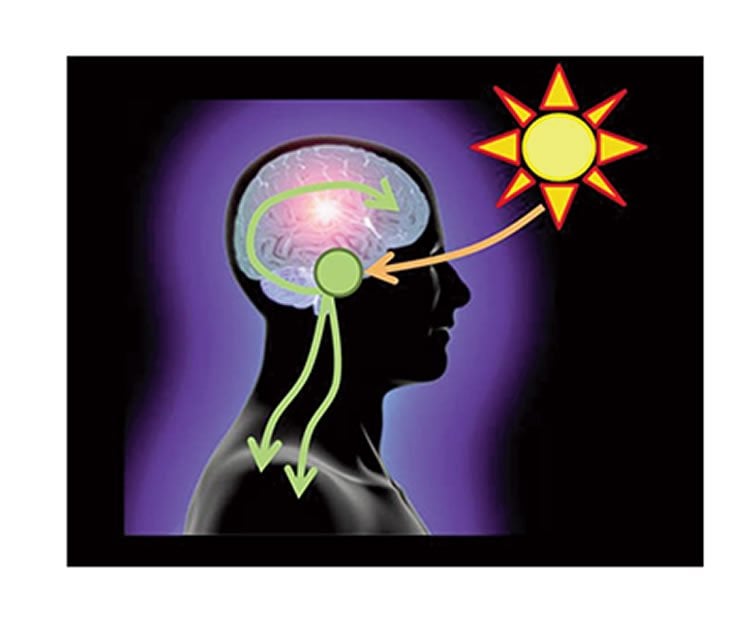Scientists have uncovered how pacemaker neurons are synchronized at dusk and dawn in order to maintain the proper functioning of their biological clocks. Their findings, which appear in the journal PLOS Biology, enhance our understanding of how sleep-wake cycles are regulated and offer promise for addressing related afflictions.
“We’ve known for some time that the time-keeping of our biological clocks is a complex enterprise,” says New York University’s Justin Blau, a professor of biology and neural science and one of the study’s co-authors. “But our results offer new details on how clock neurons work together to keep each other in check.”
The study also included researchers from the University of Michigan and the University of Houston.
They examined the biological, or circadian, clocks of Drosophila fruit flies, which are commonly used for research in this area—earlier studies of “clock genes” in fruit flies allowed the identification of similarly functioning genes in humans.
While scientists have a firm understanding of how biological clocks work within individual cells, it is less clear how individual cells tick in time together. Such an understanding is vital so that an organism has one coherent sense of time.

This dynamic was the focus of the PLOS Biology study.
The researchers focused on eight master pacemaker neurons (LNvs) located in the central brain —these neurons set the timing of the daily transitions between sleep and wake in the fly.
Specifically, they examined the signals coming in to these eight LNvs. The researchers found that LNvs need two synchronizing signals: they signal to each other at dawn and receive a signal from a second group of clock neurons at dusk. The LNvs start to desynchronize very quickly in flies lacking either of these synchronizing signals, showing how active and important this process is. And in flies lacking both of these signals, the LNvs show weak clock gene rhythms and disrupted sleep/wake cycles.
The researchers point out their findings shed new light on what occurs at dusk—and the significance of the timing of this signaling.
“Scientists already knew about the signaling at dawn, but we hadn’t previously known about the signaling that occurs in the evening,” explains Blau. “We can see how delicate this process is–and treatments to desynchronize clocks might even allow us to reset our clocks more quickly to a new time zone, which would be invaluable in jetlag.”
The research was supported, in part, by grants from the National Institutes of Health (C06 RR-15518-01, R00NS62953, R01NS077933, AA016140, and GM063911).
Contact: James Devitt – NYU
Source: NYU press release
Image Source: The image is credited to Voigt et al/NIH/NIAAA and is in the public domain
Original Research: Full open access research for “Differentially Timed Extracellular Signals Synchronize Pacemaker Neuron Clocks” by Ben Collins, Harris S. Kaplan, Matthieu Cavey, Katherine R. Lelito, Andrew H. Bahle, Zhonghua Zhu, Ann Marie Macara, Gregg Roman, Orie T. Shafer, and Justin Blau in PLOS Biology. Published online September 30 2014 doi:10.1371/journal.pbio.1001959
Differentially Timed Extracellular Signals Synchronize Pacemaker Neuron Clocks
Synchronized neuronal activity is vital for complex processes like behavior. Circadian pacemaker neurons offer an unusual opportunity to study synchrony as their molecular clocks oscillate in phase over an extended timeframe (24 h). To identify where, when, and how synchronizing signals are perceived, we first studied the minimal clock neural circuit in Drosophila larvae, manipulating either the four master pacemaker neurons (LNvs) or two dorsal clock neurons (DN1s). Unexpectedly, we found that the PDF Receptor (PdfR) is required in both LNvs and DN1s to maintain synchronized LNv clocks. We also found that glutamate is a second synchronizing signal that is released from DN1s and perceived in LNvs via the metabotropic glutamate receptor (mGluRA). Because simultaneously reducing Pdfr and mGluRA expression in LNvs severely dampened Timeless clock protein oscillations, we conclude that the master pacemaker LNvs require extracellular signals to function normally. These two synchronizing signals are released at opposite times of day and drive cAMP oscillations in LNvs. Finally we found that PdfR and mGluRA also help synchronize Timeless oscillations in adult s-LNvs. We propose that differentially timed signals that drive cAMP oscillations and synchronize pacemaker neurons in circadian neural circuits will be conserved across species.
“Differentially Timed Extracellular Signals Synchronize Pacemaker Neuron Clocks” by Ben Collins, Harris S. Kaplan, Matthieu Cavey, Katherine R. Lelito, Andrew H. Bahle, Zhonghua Zhu, Ann Marie Macara, Gregg Roman, Orie T. Shafer, and Justin Blau in PLOS Biology, September 30 2014 doi:10.1371/journal.pbio.1001959.






